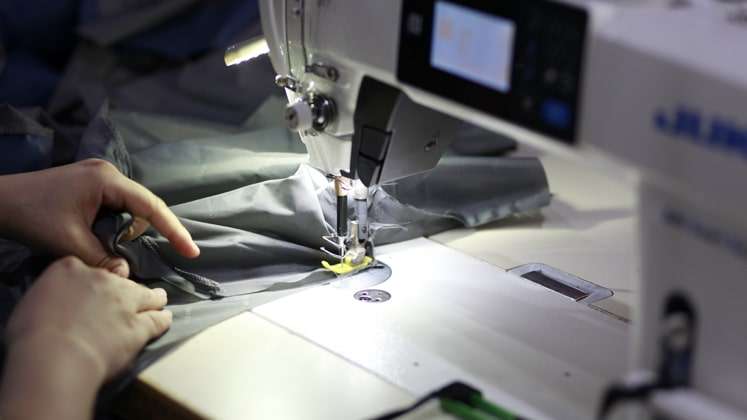
There are two aspects of high-end technology integration in the manufacturing industry – automation through robotics (3.0) and connected factories through internet (4.0). It is quite essential to understand the difference between these methods. Robotics is a concept originated in the third Industrial Revolution where electronics helped the industries achieve automation, while the fourth Industrial Revolution works solely on cyber connectivity and helps all the machines/equipment to get connected altogether and the data then gets transmitted to one common server named cloud. Both the concepts are largely being used by sectors like automotive and IT and have been giving desired results.
However, as far as the garment manufacturing industry is concerned, Industry 4.0 is still far away from the reach of the sewing floor, especially in the Asian countries. Lack of understanding of utilisation of advanced automation, labour-intensive approach and the big basket of product categories are major reasons behind it. On the other hand, high-end automation has always been a forte of the USA and Europe where cheap and skilled workers are hard to be found so high-end automation and robotic sewing are the only ways for the manufacturing factories to adopt.
For example, a company in the USA named SoftWear Automation offers Sewbots but only for t-shirt manufacturing. T-shirt, as we know, is one of the simple products to sew which does not have complexities at all. When product categories get upgraded and use of more delicate and high-end fabrics is involved with a lot of value addition (sequins, embroidery, etc.), these Sewbots fail to deliver the desired results.
Another constraint due to which robotics is not successful is the flexibility of fabric. The fabric is so delicate and flexible that robots cannot handle it in a way that human can. It is difficult for robots to pick and place delicate fabrics on sewing plate and do complicated sewing process on complex garment designs. However, straight stitches in simple garments like t-shirt, shirt and jeans are still somehow possible to sew from robotic arms.
For example, Italian jeans automation company Vibemac has already introduced its upgraded loading station for the back pocket hemmers units for jeans. The unit is upgraded version of its V700LDR automat and it can be equipped with an automatic feeding station which consists of 4 loading docks. A specialised loading device can transfer the pockets to the transport belt through a robotic arm. And, once the pockets are hemmed, an un-loader automatically stacks the pockets, order-wise, on the storage disk at the end of the transport belt.
Industry 4.0 simply means internet connected factory
Now, if we talk about Industry 4.0, there is still a lot of development pending. It simply means internet connected factory wherein Internet of Things (IoT) comes into play. According to Rakhil Hirdaramani, Director, Hirdaramani Group , Industry 4.0 is the concept of cyber and physical systems working together to create a virtual/digital ecosystem on the shop floor to provide decision-makers with real-time actionable data upon which they could act instantly. To cater to the industry’s technical and challenging needs, the industry has to adopt a hybrid approach. “Every minute counts in the apparel industry. As such, the need for real-time information is crucial. When a single production line produces close to 300 units an hour, decision-makers can’t afford to wait hours for manually generated quality reports to be compiled, to make decisions,” said Rakhil.

He further corroborated that there is an incredible amount of duplication in the apparel industry and the immediate opportunity is with the digitisation of management operations. That’s why, through an investment arm, Hirdaramani Investments, the group took the decision to seed Res.Q – production management software. What the team of Hirdaramani has done is that it developed a manufacturing suite of solutions that are focused on digitising the shop floor.
“We struggled with finding a comprehensive solution for our manufacturing business. Our team from H-One saw this as an opportunity and decided to study the way a typical factory operates,” averred Rakhil. From that, Hirdaramani Group opted to develop the following modules:
QMS – Quality Management for End Line & Final Inspection
MI – Machine Inventory
SKM – Skill Matrix
SL – Smart Line Management
MES – Manufacturing Execution System
FI – Fabric Inspection
The whole premise was to build an ecosystem that integrates with other tools such as Fast React, GSD and ERPs and creates a Digital Feedback loop to ensure that the group cuts through management layers to provide its workers with the information to make decisions in real-time.
“What is exciting for Res.Q is that we are seeing an acceleration of what we envisaged when we developed the software,” informed Rakhil. With social distancing likely to continue, the Hirdaramani Group sees Res.Q as a perfect cloud-based solution.
By working on Microsoft’s Azure platform, it is able to access the tool from anywhere and reduce the requirement of team members being in close proximity to each other. As managers can’t always be present on the factory floor and many a time, they need to manage several factories and travel between them, they need to be able to access information and make time-sensitive decisions on the go, wherever they are. Res.Q creates a data-driven shop floor that enables users to make better informed day-to-day production related crucial decisions.
In a factory where Res.Q is deployed, the quality inspectors are equipped with a tablet that provides them with a real-time understanding of whether garments produced ascribe to accepted quality standards. If there is a defect in an item, the quality inspector can immediately address the issue at the point of cause. Not only them, but also the sewing operators will get a complete visibility into their defect counts with the help of LCDs on the shop floor indicating the number of defects in each production line. This Industry 4.0 solution will also help managers analyse trends, make strategic decisions and resolve systemic issues.
“Res.Q even helps organisations to identify production lines with higher defect rates and detect precise skill gaps and training needs right down to the operation. Instead of holding mass training sessions for sewing operators, which take them away from the production line, sometimes for extended periods of time, it enables management as well as the HR to provide much more focused training to the team members who require it, and to make the most use of their training dollars,” shared Rakhil.
Is there a need for gradual transition from 3.0 to 4.0?
The manual and conventional systems that were responsible for apparel industry’s initial development are unable to keep it competitive anymore. Due to high levels of competition and the emergence of new manufacturing destinations, processes and costs have never been tighter. Manufacturers turn to technology to find an edge over their competitors. The gap that exists is that large apparel companies tend to invest in technology, but the vast majority of apparel manufacturers do not.
One of the major issues factories in Asia are facing is the increasing gap between sewing time and handling time. According to a recent survey done by Japanese sewing technology provider Brother, sewing time in Bangladeshi factories is just 15 per cent compared to handling time which stands at around 85 per cent. This sewing time is the second lowest after India among top Asian garment manufacturing countries such as China, Bangladesh, Myanmar, Vietnam and Indonesia. IoT helps factories reduce this handling time and further assists factories to not remain dependent on a human element to scan any piece or to press any button on the machine. However, is it viable for manufacturers to take a sudden jump from their traditional approach to Industry 4.0 implementation?
Habibur Rahman, a Smart Factory and Industry 4.0 Consultant, Bangladesh , told that a step-by-step transition is always recommended. “The industrial revolution 3.0 started in 1969 and our industrial factories continue to be the continuation of the third industrial revolution. How do we upgrade the industrial revolution from 3.0 to 4.0! We need to be able to achieve some degree of excellence now and need to identify those things which we still handle incorrectly.”

The low capacity planning of the Bangladeshi factories is one major prolonged issue for the owners. If a t-shirt factory of 30 lines produces 2,000 t-shirts per line per day, then the monthly output of t-shirts from the factory should be around 1.56 million pieces which is not the case with majority of the factories. According to Habibur, the maximum output in such cases is 1.25 million pieces and this catastrophe has been going on for over two decades.
The reason behind this shortfall is the wastage of 5-6 days due to changeover in lines, machine failure, absence of operators, cutting bundle unavailability on sewing machines and less communication between team members. In this case, bringing Industry 4.0 concept directly is not at all a viable solution. “For this, training on automation and less dependence on human intervention is needed which is usually a part of 3.0 concept,” opined Habibur, adding, “I am providing consultancy to eliminate all these loopholes in order to see a better productive Bangladesh.”
To improve digital connectivity of the Bangladeshi factories, Habibur further works on two concepts – Robotic Process Automation (RPA) and IoT. RPA is the technology that allows factories today to configure computer software, or a ‘softbot’ to emulate and integrate the actions of a human interacting within digital systems to execute the processes. RPA softbots utilise the user interface to capture data and manipulate applications just like humans do. They interpret, trigger responses and communicate with other systems in order to perform on a vast variety of repetitive tasks. Only substantially better: an RPA softbot never sleeps and makes zero mistakes.
Explaining its significance, Habibur sheds light on an important example. As per him, the buyers’ data come to the factories in Bangladesh mostly at nights and factory management starts working on it only the next day, and the process of understanding this data consumes whole 24 hours. “RPA lets factories not waste these 24 hours, as it’s working 24×7 to accept data and analyse it further to come up with a certain set of information directly through buyers’ PLM software,” shared Habibur, adding, “This way lead time is improving.” It’s worth mentioning here that RPA softbot has been running as a pilot project in three Bangladeshi factories with over 65 per cent accuracy level and day by day it is claimed to be increasing.
Further, as part of the move by Smart Factory 4.0 Solutions, Habibur has started working to bring all factories across Bangladesh into Amazon Cloud Service, asking everyone to join this digital journey. “I believe that if we can build this connectivity and share the capacity of all, we can produce 15 per cent more. Then the apparel export from will be US $ 39.10 billion from US $ 34 billion at present,” said Habibur, concluding, “I and my team are also working with technologies like Automated Guided Vehicle, Digital Supply Chain Management System, Collaborative Robot in few Critical zones, Hazardous area, Face Recognition for attendance and Man power Management, Augmented Reality/Virtual Reality for Training, Factory Tour and other area.”

Post a Comment